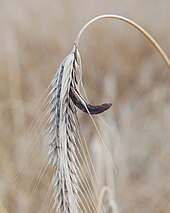Clavorubin
| Structural formula | |||||||||||||
|---|---|---|---|---|---|---|---|---|---|---|---|---|---|

|
|||||||||||||
| General | |||||||||||||
| Surname | Clavorubin | ||||||||||||
| other names |
|
||||||||||||
| Molecular formula | C 16 H 10 O 8 | ||||||||||||
| External identifiers / databases | |||||||||||||
|
|||||||||||||
| properties | |||||||||||||
| Molar mass | 330.25 g mol −1 | ||||||||||||
| Physical state |
solid (as methyl ester) |
||||||||||||
| Melting point |
259 ° C (as methyl ester) |
||||||||||||
| pK s value |
4.2 |
||||||||||||
| solubility |
hardly soluble |
||||||||||||
| safety instructions | |||||||||||||
|
|||||||||||||
| As far as possible and customary, SI units are used. Unless otherwise noted, the data given apply to standard conditions . | |||||||||||||
Clavorubin is an organic compound and belongs to the group of dyes red anthraquinone . Clavorubin is one of the first group of pigments found in ergot to be identified. These are characterized by their increased acidity and intense color.
Occurrence
Both clavorubin and endocrocin could be detected in the saprophytic culture of purple-brown ergot fungus . It is therefore assumed that these are typical metabolic products of the fungus. The content of clavorubin in ergot is 0.02 g · kg −1 .
synthesis
The research into the connection between alkaloid and dye formation, as well as the elucidation of the structures of the same, can be traced back to the work of Burchard Franck . Compared to endocrocin , clavorubin only contains one additional hydroxide group . That is why clavorubin can be produced synthetically through the specific oxidation of endocrocin with manganese dioxide and sulfuric acid. Due to their very stable structure, anthraquinone dyes were accepted as end products of the metabolism of plants. Ten years after his discovery, Franck found out that they are further processed into yellow xanthone compounds by oxidative ring opening .
See also
literature
- Hegnauer, R. (1962) :: Chemotaxonomy of plants: An overview of the distribution and the systematic importance of plant substances, 1st volume: Thallophyten, Bryophyten, Pteridophyten und Gymnospermen, Basel: Birkhauser Verlag, pp. 149-150.
- Roth, K. (2010): Chemical delicacies . 1st edition, Weinheim: Wiley-VCH, ISBN 978-3-527-32752-2 , p. 92.
Individual evidence
- ↑ a b Chemsrc: 2960-94-3 .
- ^ A b Franck, B. & Zimmer, I .: Constitution and synthesis of clavorubin , Chemical Reports , 1965 , 98 (5) , 1514–1521, doi: 10.1002 / cber.19650980527 .
- ↑ a b c d e Franck, B .: Structure and Biosynthesis of Ergot Dyes , Angewandte Chemie , 1969 , 81 (8) , 269–278, doi: 10.1002 / anie.19690810802 .
- ↑ This substance has either not yet been classified with regard to its hazardousness or a reliable and citable source has not yet been found.
- ^ A b Franck, B .: Die dyes des ergot , 8th conference of the German Society for Medicinal Plant Research October 23, 1960 , No. 4 , 420-429.
